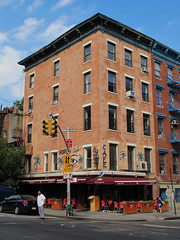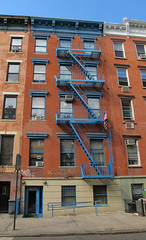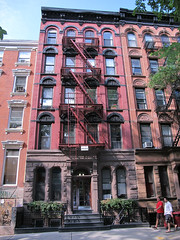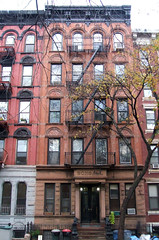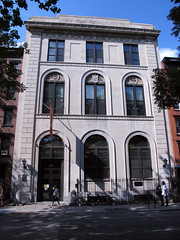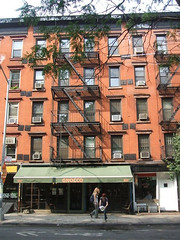Tomorrow, a public hearing by the Landmarks Preservation Commission will determine the future of East 10th Street along Tompkins Square Park. Over the weekend, The Local spoke with Andrew Berman, the executive director of the Greenwich Village Society for Historic Preservation, about the history of the strip.
293 East 10th Street
This building, like a lot of buildings in the East Village, shows in a very material way the evolution of the neighborhood from a place of single-family homes for the merchant class to the locus of immigration to New York City. It was built at the corner of East 10th and Avenue A in 1845 for James French, a boot-maker.
Only five years later it was sold to a gentleman named Joshua Varian and a Haraim Chandler leased it from him. Chandler lived with seven other families. This building very quickly became a multi-family home, or a tenement. By the late 1890s it was owned by Charles J. Smith, whose name still appears on the top left-hand side of the building. The top floor of the building was probably added by Smith as part of the tenementi-zation of it.
Interestingly, we know that Chandler worked for the N.Y.P.D. very early in its existence; it was only founded in 1845. Chandler worked as a detective and was injured during the 1863 draft riots. He died in 1881.
295 East 10th Street
This one was also built in 1845 for James French, and also sold to Varian in 1850. The latter lived in this building with his family and two young women from Ireland, who were perhaps servants. Varian had a stand in the Catherine Market in Lower Manhattan, though we don’t know what he sold.
From 1875 to 1920 it was owned by Bernard Toch, a German immigrant who owned a paint store at 35 Bowery. In the 1920s it was owned by Julius Martenson, who lived there. He ran a store in the basement that sold European phonographs. He altered the building by creating a storefront, which led to loss of the stoop. It’s another example of the tenement-ization and commercialization process — many stoops were lost that way.
313, 315, 317 East 10th Street
All three of these were built in 1847. 313 and 315 were built for S. Perkins, and from 1856 to 1910 they housed St. Brigid’s Academy, which was run by the Sisters of Charity of St. Paul. It was a school for about 200 girls, many of whom lived in the buildings. Around 30 nuns lived in the two buildings as well. Some of the nuns stayed as late as 1920.
The building at 313 was sold to Samuel Horowitz for $36,000. Horowitz was the president of Horowitz Brothers, which were matzoh makers in the Lower East Side. Horowitz resold the property to Kollel Shomrei Hachomos, a Hungarian-Jewish benevolent society. In 1947 the building was sold to the Slovak Social Welfare Club. A memorial plaque in Tompkins Square Park is dedicated to one of the welfare club’s members, a Milan Stefanik.
In 1921 Margaret Sanger rented space in the building at 321 for a birth control clinic. It would have been the first of its kind in the country, but Sanger found that she couldn’t legally operate a clinic in that space. So she opened the first one nearby, at 104 Fifth Avenue in 1923.
321, 323 East 10th Street
These are two of the youngest buildings on the block. Both were built in 1888. There were two apartments per floor, and each apartment went from the front of the building to the back. There are six or seven rooms per apartment, with each one after the other — that’s why they’re called railroad flats.
This is a purpose-built tenement. There were three different eras for tenements: pre-law, when there were no regulations; then old law, like these buildings, when the very first regulations were put in place requiring some light and air to reach every room in the building. From above, this type of building took the rough shape of a dumbbell, leading them to be known as dumbbell tenements. Then there’s the new laws, which were passed in 1901. They contained more significant requirements for healthy living conditions.
I would guess that most of those apartments probably had an average of 10 people per unit, so there were around 100 people in each building.
331 East 10th Street
This is the youngster on the block. It was built in 1904 by Mckim, Mead and White, the grandest of architects at the turn of last century. This was one of the first Carnegie libraries in New York City, and built just after the consolidation of the five boroughs. When Andrew Carnegie donated over $5 million to create a branch-library system, the trustees wanted locations to be built in conspicuous and well-traveled streets. This one worked because of its proximity to Tompkins Square Park and other community institutions. Large sections of the neighborhood would pass by it. Given that many people weren’t literate, the way for them to find out about the library would be to actually see that it is there.
When the library opened there were 16,000 books. It was an individually-designated landmark in 1999. It’s the one building within the proposed district that is already a landmark.
337 East 10th Street
Nobody is sure when the first purpose-built tenement was made in New York City. They were very uncommon until after the Civil War, when large-scale immigration and industrialization began. While the building is not exceptional, it is rare to see tenements such as these that were built pre-Civil War in 1859 and 1860. It’s an example of pre-law tenements — it was like the wild west.
In 1907, Max Tanenbaum owned the building. The surname is probably a reflection of the neighborhood having become predominately Jewish at that point. He removed sinks and outhouses from the rear yard and replaced them with communal indoor water closets. It was the first indoor plumbing for the building. You wouldn’t have had to walk out to rear yard in middle of night if you wanted to use the bathroom.
This post has been revised to reflect the following correction:
Correction: January 17, 2011
An earlier version of this post misspelled the name of the Hungarian-Jewish benevolent society located at 313 East 10th Street. It is Kollel Shomrei Hachomos.



